Biermann Ch. Handbook of Pulping and Papermaking
Подождите немного. Документ загружается.


704 34. UPDATES AND BffiLIOGRAPHY
Agglomeration deinking is a relatively new
method of deinking that is applied to office papers
printed with laser printing inks. Betz and PPG
offer chemistry systems in this area. Surfactants
are used to agglomerate small particles of ink into
large particles that can be removed by screens or
forward hydrocleaners.
Snyder, B.A. and J.C. Berg, Liquid bridge ag-
glomeration: a fundamental approach to toner
deinking, Tappi J. 77(5):79-84(1994).
Enzymatic
deinking,
Biodeinking
Welt, T. and R.J. Dinus, Enzymatic deinking—a
review, Progress Paper Recycling 4(2):36-
47(Feb., 1995), with 81 references. Enzymatic
deinking uses cellulases (to, hypothetically, re-
move the fibrils from the surface of fibers where
the ink anchors itself to the fiber), hemicellulases,
pectinases, or, less studied, esterases (lipases),
which would saponify inks with triglycerides (soy
bean oil). The process was not commercial at the
time of this article.
Changes in ink formulations
Trends in ink formulations to decrease their
impact on the environment and make printed
papers easier to recycle include the decrease in the
use of volatile organic compounds (VOC, i.e.,
hydrocarbon and other solvents). Corrugated
flexo inks recently were 10—20% VOC, but now
range from 0—2%. The use of appreciable
amounts of heavy metals in inks is under attack.
Reductions in lead, chromium, copper, and, to a
lesser extent, barium have begun to occur.
Use of
ONP
in OCC
The use of ONP in OCC allows a higher
level of postconsumer waste to be included in
OCC,
which is important for some classifications
of paper. The strength of ONP can be increased
by chemical treatment (such as with NaOH),
refining, the use of starch adhesives, and fiber
fractionation.
General aspects
When using batch pulping, high consistency
is usually preferable; however, newsprint is
sometimes pulped in continuous pulpers at low
consistency. The hole size in pulpers is often 1/4,
1/2, or 3/4 in. in diameter.
Three inch forward cleaners are used at 0.7
to 0.8% consistency unless the fibers are fairly
short, when up to
1 %
consistency is used. Four
inch cleaners are used at
1 %
consistency.
One method to improve the quality of recy-
cled fiber is to fractionate it by size; OCC can be
fractionated into small fibers for use in corrugating
medium and large fibers to be used in linerboard.
Bobalek, J.F. and M. Chaturvedi, The effects of
recycling on the physical properties of handsheets
with respect to specific wood species, Tappi /.
72(6):
123-125(1989).
Ibid., Tappi Proceedings,
1988 Pulping Conference, pp. 183—187. Com-
mercial bleached kraft loblolly pine, eucalyptus,
quaking aspen, and northern pine were subjected
to 0—3 cycles of handsheet formation without wet
pressing (with light refining) with concomitant
strength and other properties reported. It is
unclear whether these handsheets were air dried or
oven dried, but these conditions do not seem to
duplicate commercial production practices.
Cox, J., Wastepaper growth highlighted in API's
capacity survey. Am. Papermaker 54(2):37-
40(1990).
lannazzi, F.D. and R. Strauss, Municipal solid
waste and the paper industry: the next five years,
Pulp & Pfl/7^r64(3):222-225(March, 1990).
Olkinuora, M., U.S. leads the world in the pro-
duction and consumption of wastepaper, Pulp &
Pap^r
64(3):
130-132(March, 1989). This paper
gives figures for 1986 when the U.S. was recover-
ing 27.4% of its waste paper. By 1990 this figure
was over 30% and will most likely continue to rise
as pressure mounts to reduce the amount of solid
waste going into landfills, of which waste paper is
approximately 50% of domestic waste. Japan
recovers about 50% of its paper, which is near the
sustainable maximum as fibers lose strength with
each use.
Sorenson, D., Environmental concerns, economics
drive paper recycling technology. Pulp & Paper
64(3)56-57:(March, 1990).
Gyrocleaner
Marson, M., New lightweight cleaner units solve
mill's plastic problems. Pulp & Paper 64(6):93-
96(1990). The development and operation of the

RECYCLING AND SECONDARY FIBER 705
Gyrocleaner mentioned and shown on page 271 of
this book are described.
Flotation deinking vs. flotation clarification
Doshi, M.R., Flotation deinking vs. flotation
clarification, Progress Paper Recycling 1(2):
83(Feb., 1992).
Dispersed—air flotation deinking is a separa-
tion process where ink is separated from fiber (a
selective process). Large bubbles are used, 0.1 to
1.0 mm in diameter, that quickly rise to the
surface, leaving fibers behind; particles must be
relatively large and hydrophobic to be removed.
Dissolved—air flotation clarification to clean
process water, however, is designed to remove all
particles (a collective process). Small air bubbles
are used, 0.01 to 0.1 mm, under conditions of
relatively low turbulence.
Stickles
Several mills report that the use of
0.006
in.
slotted screens has appreciably decreased the
problems associated with stickles in recycled pulp.
Doshi, M.R., Properties and control of stickles.
Progress Paper Recycling l(l):54-63(Nov., 1991).
Doshi, M.R., Quantification, control, and reten-
tion of depositable sfickies, Progress Paper Recy-
cling 2(l):83(Nov., 1992). These two articles are
the basis of the discussion in this section.
Stickles are designated as either micro or
macro because these two classes behave differently
during the papermaking process. Micro stickles
are smaller than 150 /xm and will pass through a
0.006
in. slotted screen. A second classification
is passing through a 200 mesh screen (< 76 ^m).
Microstickies are determined by tests such as
those of Buckman (plastic bottle), Berol (poly-
propylene film), Doshi (microfoam), and PIRA
(paper machine wire). Talc and zirconium are
used for the control of microstickies.
Macrostickies are determined by making
handsheets that are then hotpressed and dried.
The stickles are determined by counting with the
needle nest, counting specks with the Tappi meth-
od, or dying the fibers with a water—soluble black
dye.
Another method that requires standards dyes
the stickles with a water—insoluble dye.
Some manufacturers say talc and related
materials remove macro stickles by increasing
their density and allowing their removal in forward
cleaners, but this is probably not true.
Twin—wire machines seem to have more
difficulty with stickles (wire plugging) than
fourdrinier machines. In addition to talc, zirconi-
um compounds are also used for stickles control.
Sticky control agents should be added after
the refiners, but as far upstream as possible to
allow them ample time to work. Control agents
include talc (used at 0.6—2% on pulp),
dispersants, zirconium compounds
(0.1 %
on pulp),
and alum sequestering agents (to prevent agglom-
eration of
stickles).
Synthetic fibers were used at
one time (0.1% on pulp), but this method is no
longer used.
Dirt
counting
Glowacki, J.J., Ponderosa boosts dirt count accu-
racy with PC/scanner, Pulp & Paper 69(2):93-
94(1995). Dirt counting has come a long way
over the last several years. This system uses a
standard computer image scanner with software to
give a dirt size distribution analysis. These sys-
tems are easy to use, highly repeatable, and quick.
34.6 PROPERTIES OF PULPS
Comparison
of pulping methods
There are several papers in the literature that
compare the strength and other properties of paper
made with various pulping methods, cooking
times,
and refining levels. These studies are
usually conducted on laboratory-made pulps and
handsheets.
Liebergott, N. and T. Joachimides, Choosing the
best brightening process. Pulp Paper Can,
80(12):T391-T395 (1979).
Wegner, T.H., G.C. Myers and G.F. Leatham,
Biological treatments as an alternative to chemical
pretreatments in high yield wood pulping,
Tappi
J.
74(3):
189-193(1991).
This paper includes fiber
classification by Bauer—McNett analysis.
34.7 MECHANICAL PULPING
Thermomechanical
methods
Prusas, Z.C, M.J. Rourke, and L.O. Uhrig,
Variables in chemi—thermomechanical pulping of

706 34. UPDATES AND BIBLIOGRAPHY
northern hardwoods,
TappiJ.
70(10):91-95(1987).
The concentrations of NaOH in the first stage and
sulfite in the second stage of Mead's CTMP
process were investigated with refining energy and
other pulp and paper properties reported. Some
good basic data for these parameters are included.
Biomechanical pulping
Biomechanical pulping is an experimental tech-
nique where wood chips are inoculated with
specific types of decay fungi (especially white rot)
or lignin—degrading enzymes to break some lignin
bonds prior to mechanical pulping; this offers the
advantages of reducing power requirements in the
refiners and giving higher strength pulps.
Akhtar, M., M.C. Attridge, G.C. Myers, T.K.
Kirk, andR.A. Blanchette, Biomechanical pulping
of loblolly pine with different strains of the
white—rot fungus Ceriporiopsis subvermispora,
TappiJ.
75(2):
105-109(1992), with 24 references.
34.8 CHEMICAL PULPING
Digesters
Horng, A.J., D.M. Mackie, and J. Tichy, Factors
affecting pulp quality from continuous digesters,
Tappi J. 70(12):75-79(1987). One important
factor that influences pulp quality from a continu-
ous digester is the rate of liquor circulation.
Kraft process, general aspects
Pulp and Paper
Manufacture,
Volume 1, 2nd ed.,
MacDonald, R.G., Ed., McGraw-Hill, New
York, 1969, pp. 347-627 (Chap. 8-10). Espe-
cially noteworthy are the history of the process,
the liquor impregnation discussion, the demon-
stration of carbohydrate removal by type of carbo-
hydrate and pulping process, the effect of chip
quality on kraft pulping, the effect of effective
alkali charge, effective alkali concentration, and
sulfidity on the pulping of Douglas—fir sawdust,
sweet gum, and other species, and a table with
H—factor as a function of temperature in Chapter
8. Chapter 10 is an expansion of the article by
Swartz directly below with (in addition to most of
the above) information on process control, contin-
uous pulping, causticizing curves, chemical com-
positions at various points in causticizing, per-
formance of rotary kilns as a function of size,
liquor titration
calculations,
and material specifica-
tions for construction of equipment. Chapter 11
discusses the thermodynamics of the kraft recovery
cycle with an energy balance around the recovery
process based on one ton of pulp. Much of the
last chapter was from the first edition of 1950.
Swartz, J.N. and R.C. MacDonald, Alkaline
pulping, in Pulp and Paper Science and Tech-
nology, Volume 1, Libby, C.E., Ed. McGraw-
Hill, New York, 1962, pp. 160-239. This is a
discourse on alkaline pulping from an engineering
viewpoint including information on chemical
recovery, the development of
the
modern recovery
boiler, mass balances of cooking and washing,
heat transfer reactions, heat balance of multiple
effect evaporators, and tall oil and turpentine
recovery. A table relates Baume to solids content
(from 13.2—54.7% solids) to the specific gravity
of black liquor from a southern kraft mill. (Spe-
cific gravity is a very usefiil method for determin-
ing solids content of black liquor if calibrated by
gravimetric analysis for a given mill.)
Schwartz, S.L. and M.W. Bray, Chemistry of the
alkaline wood pulp processes, V. Effect of chemi-
cal ratio at constant initial concentration and the
effect of initial concentration of the rate of
delignification and hydrolysis of Douglas—fir by
the sulphate process, Techn. Assoc. Papers
22(600)1939. The comprehensive study of the
effect of effective alkali charge and effective alkali
concentration on the pulping (as yield and lignin
content) of Douglas—fir sawdust mentioned in the
reference immediately above is from this article.
Kraft pulping chemistry
Chiang, V.L., et al.. Alkali consumption during
kraft pulping of Douglas—fir, western hemlock,
and red alder,
TappiJ.
70(2):
101-104(1987).
This
study shows that 22% of the EA was used for
initial delignification of the softwoods while alder
required about 40%. Only about 2—4% NasO on
wood was required for bulk delignification of the
three species, although this accounts for about
70%
of lignin removal. (Studies like this indicate
why RDH pulping is so effective.)
Milanova, E. and G.M. Dorris, On the determina-
tion of residual alkali in black liquors, Nor. Pulp
Paper
Res.
J. 4(l):4-9, 15(1994). The concept of
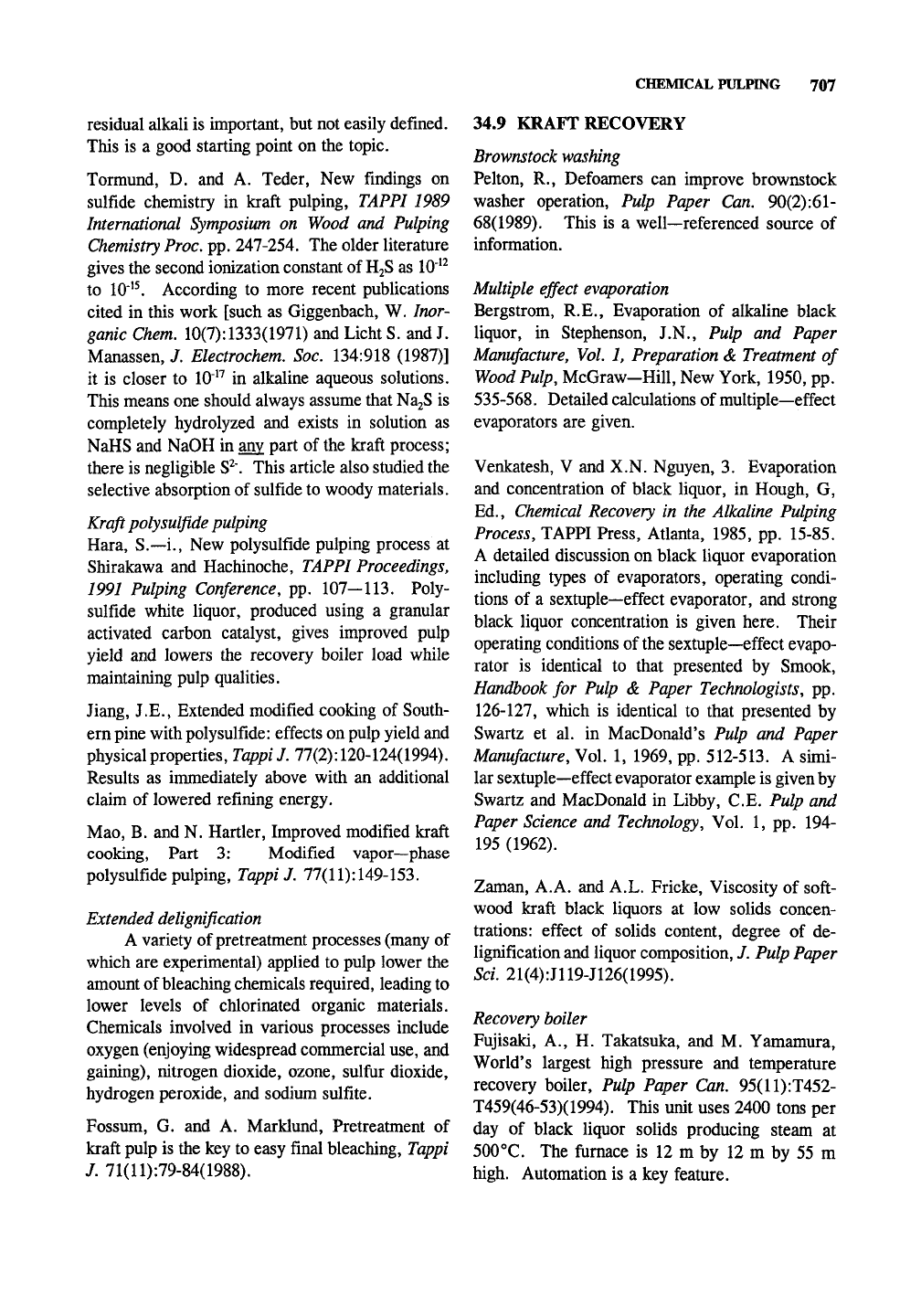
CHEMICAL PULPING 707
residual alkali is important, but not easily defined.
This is a good starting point on the topic.
Tormund, D. and A. Teder, New findings on
sulfide chemistry in kraft pulping, TAPPI1989
International Symposium on Wood and Pulping
Chemistry
Proc.
pp. 247-254. The older literature
gives the second ionization constant of HjS as 10'^^
to 10'^^ According to more recent publications
cited in this work [such as Giggenbach, W. Inor-
ganic Chem.
10(7):
1333(1971) and Licht S. and J.
Manassen, /. Electrochem. Soc. 134:918 (1987)]
it is closer to 10"^^ in alkaline aqueous solutions.
This means one should always assume that NajS is
completely hydrolyzed and exists in solution as
NaHS and NaOH in any part of the kraft process;
there is negligible
S^".
This article also studied the
selective absorption of sulfide to woody materials.
Kraft
poly
sulfide pulping
Hara,
S.—i.,
New polysulfide pulping process at
Shirakawa and Hachinoche, TAPPI Proceedings,
1991 Pulping Conference, pp. 107—113. Poly-
sulfide white liquor, produced using a granular
activated carbon catalyst, gives improved pulp
yield and lowers the recovery boiler load while
maintaining pulp qualities.
Jiang, J.E., Extended modified cooking of South-
ern pine with polysulfide: effects on pulp yield and
physical properties,
TappiJ.
77(2):
120-124(1994).
Results as immediately above with an additional
claim of lowered refining energy.
Mao,
B. and N. Hartler, Improved modified kraft
cooking. Part 3: Modified vapor—phase
polysulfide pulping,
TappiJ.
77(11):
149-153.
Extended delignification
A variety of pretreatment processes (many of
which are experimental) applied to pulp lower the
amount of bleaching chemicals required, leading to
lower levels of chlorinated organic materials.
Chemicals involved in various processes include
oxygen (enjoying widespread commercial use, and
gaining), nitrogen dioxide, ozone, sulfur dioxide,
hydrogen peroxide, and sodium sulfite.
Possum, G. and A. Marklund, Pretreatment of
kraft pulp is the key to easy final bleaching, Tappi
J. 71(11):79-84(1988).
34.9 KRAFT RECOVERY
Brownstock washing
Pelton, R., Defoamers can improve brownstock
washer operation. Pulp Paper Can.
90(2):61-
68(1989). This is a well—referenced source of
information.
Multiple effect
evaporation
Bergstrom, R.E., Evaporation of alkaline black
liquor, in Stephenson, J.N., Pulp and Paper
Manufacture,
Vol. 1,
Preparation
&
Treatment
of
Wood
Pulp,
McGraw-Hill, New York, 1950, pp.
535-568.
Detailed calculations of multiple—effect
evaporators are given.
Venkatesh, V and X.N. Nguyen, 3. Evaporation
and concentration of black liquor, in Hough, G,
Ed.,
Chemical
Recovery in the Alkaline Pulping
Process, TAPPI Press, Atlanta, 1985, pp. 15-85.
A detailed discussion on black liquor evaporation
including types of evaporators, operating condi-
tions of a sextuple—effect evaporator, and strong
black liquor concentration is given here. Their
operating conditions of
the
sextuple—effect evapo-
rator is identical to that presented by Smook,
Handbook
for Pulp & Paper Technologists, pp.
126-127, which is identical to that presented by
Swartz et al. in MacDonald's Pulp and Paper
Manufacture, Vol. 1, 1969, pp. 512-513. A simi-
lar sextuple—effect evaporator example is given by
Swartz and MacDonald in Libby, C.E. Pulp and
Paper
Science
and
Technology,
Vol. 1, pp. 194-
195 (1962).
Zaman, A.A. and A.L. Fricke, Viscosity of soft-
wood kraft black liquors at low solids concen-
trations: effect of solids content, degree of de-
lignification and liquor composition, /. Pulp Paper
Sci. 21(4):J119-1126(1995).
Recovery boiler
Fujisaki, A., H. Takatsuka, and M. Yamamura,
World's largest high pressure and temperature
recovery boiler. Pulp Paper Can. 95(11):T452-
T459(46-53)(1994). This unit uses 2400 tons per
day of black liquor solids producing steam at
500°C. The fiimace is 12 m by 12 m by 55 m
high. Automation is a key feature.

708 34. UPDATES AND BIBLIOGRAPHY
Ibach, S., Conversion to high solids firing. Pulp
Paper Can. 97(3):T88-94(March 1996). This is
an excellent article on the succesful operation of
kraft recovery boilers using high solids firing. It
is required reading on the topic.
Jones,
A.K. and P.J. Chapman, Computational
fluid dynamics combustion and modelling—a com-
parison of secondary air systems design, Tappi J.
76(7):
195-202(1993).
The use of CFD to model
recovery boilers is increasing.
Thorslund, G.L., Visual recovery boiler inspec-
tion, Tappi J. 77(12):65-74(1994). An inspection
plan should include the water, steam, and fire
sides with the latter including pressure parts,
attachments, casings, and wall openings.
Recovery boiler and nitrogen oxide emissions
Nichols, K.M., L.M. Thompson, and H.J. Empie,
A review of
NO^
formation mechanisms in recov-
ery furnaces, Tappi J.
76(1):
119-124(1993).
This
study claims that most of the NO^ arises from
nitrogen in the fuel.
Prouty, A.L., R.C. Stuart, and A.L. Caron,
Nitrogen oxide emissions from a kraft recovery
furnace, Tappi J.
76(1):
115-118(1993).
Ejfect of dead load on recovery & delignification
Ahlers, P.—E., H. Norrstrom, and B. Warnqvist,
Chlorides in kraft recovery: effects on process and
equipment. Pulp Paper
Can.
79(5):T169-T
173(63-
66,
68)(1978). Any mill with over 10 g/L NaCl
in the white liquor should certainly consult these
two articles.
Mortimer, R.D. and B.I. Fleming, An empirical
relationship to describe the effect of deadload on
delignification, Tappi J. 66(1):98-99(1983).
Deadload, inactive materials in kraft white liquor,
such as NaCl, NajCOa, and Na2S04, decreases the
rate of delignification. Normal levels of these
compounds in commercial kraft pulping have a
negligible effect, but some mills with high levels
of NaCl will experience a decrease in delignifi-
cation. For example, a soda—AQ black spruce
pulp with no deadload in the white liquor has a
kappa number of 53. The kappa number is in-
creased with deadload. At 37.2 g/L as NajO (of
the chemical specified): NaCl gives 68.8, NajCOs
gives 60.3, and Na2S04 gives 64.5. The log
(kappa) is proportional to the concentration of
deadload contaminant. The slope of the relation-
ship is similar for kraft, soda, and soda—AQ
pulping methods.
Novel black liquor recovery technologies
A variety of techniques are being investigated
to recover kraft liquor, especially methods that are
amenable to small scales for incremental capacity
increases. Another goal is to eliminate the possi-
bility of smelt—water explosions.
Empie, H.J, Alternative kraft recovery processes,
Tappi J. 74(5):272-276(1991). Several of these
techniques involve methods of gasification or
fluidized
beds.
The Chemrec plasma gasifier
when operated at 1250°C (2280°F) followed by
rapid cooling offers the potential of direct recov-
ery of alkali and sulfur reduction approaching
100%.
Although there is still much development
needed on this process, Kamyr plans to build a
6000 Ib/h demonstration unit.
Paleologou, M., P.—Y. Wong, and R.M. Berry,
A solution to caustic/chlorine imbalance: bipolar
membrane electrodialysis, J. Pulp Paper Sci.
18(4):J138-J145(1992). In this article sodium
sulfate was recovered as sodium hydroxide and
sulfuric acid with the application of electricity
across two ion—selective membranes.
Although not covered in this article, the same
technique can be used to recover NaCl as NaOH
and HCl. This technique can be used to recover
alkali from the alkali extraction of pulp bleaching
with the added advantage of decolorization.
Dorr—Oliver, Inc., The fluid bed calciner, in
Hough, G, Ed.,
Chemical
Recovery in the Alkaline
Pulping Process, TAPPI Press, Atlanta, 1985, pp.
299-303.
Novel black liquor
recovery,
auto—causticizing
A variety of alternate recovery processes
have been proposed. One class of these processes
are the auto—causticizing recovery methods where
an amphoteric oxide (or related material) is pres-
ent in the black liquor prior to recovery. Upon
dissolution of the smelt after combustion of the
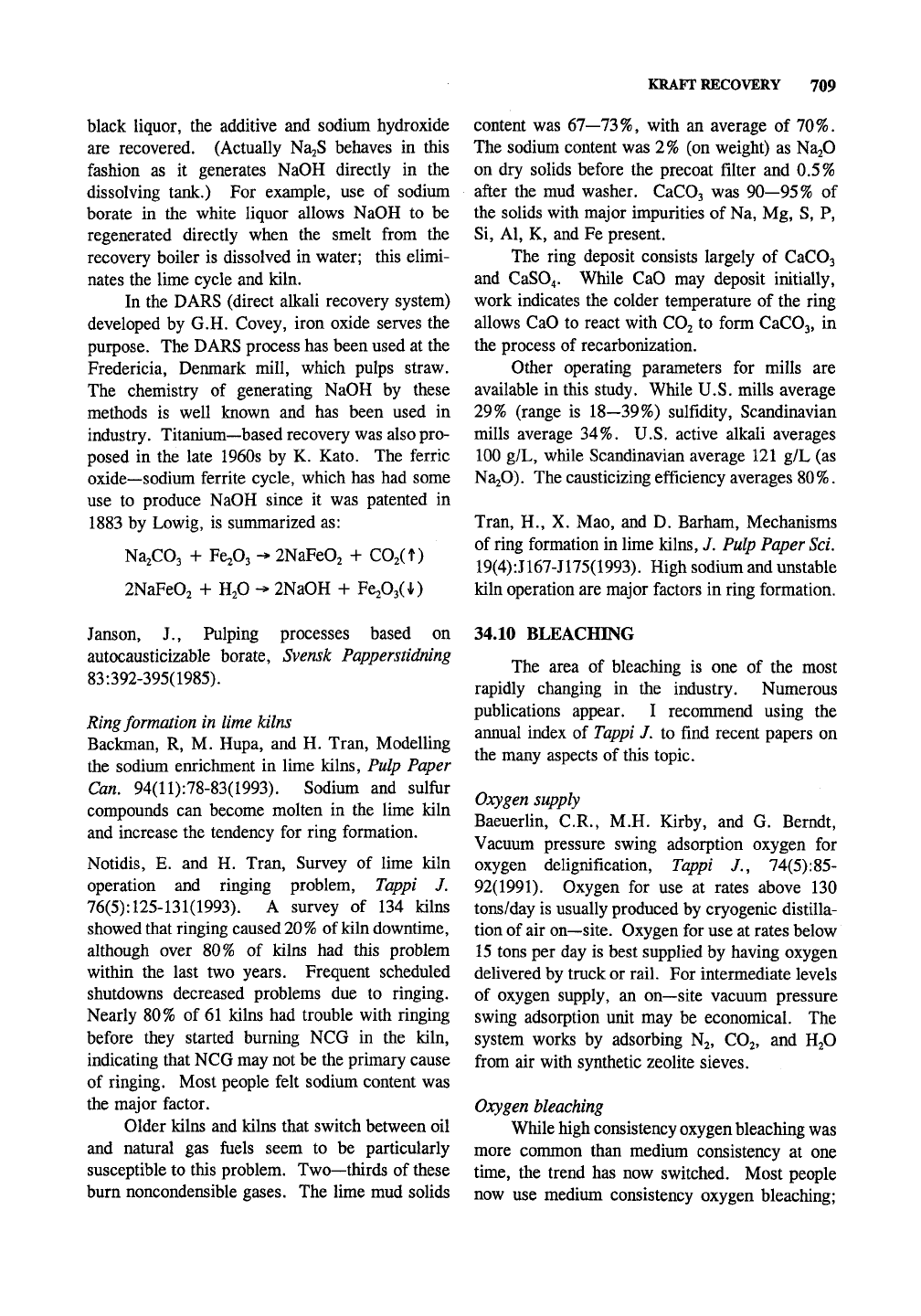
KRAFT RECOVERY 709
black liquor, the additive and sodium hydroxide
are recovered. (Actually Na2S behaves in this
fashion as it generates NaOH directly in the
dissolving tank.) For example, use of sodium
borate in the white liquor allows NaOH to be
regenerated directly when the smelt from the
recovery boiler is dissolved in water; this elimi-
nates the lime cycle and kiln.
In the DARS (direct alkali recovery system)
developed by G.H. Covey, iron oxide serves the
purpose. The DARS process has been used at the
Fredericia, Denmark mill, which pulps straw.
The chemistry of generating NaOH by these
methods is well known and has been used in
industry. Titanium—based recovery was also pro-
posed in the late 1960s by K. Kato. The ferric
oxide—sodium ferrite cycle, which has had some
use to produce NaOH since it was patented in
1883 by Lowig, is summarized as:
Na2C03 + Fe203 -^ 2NaFe02 + C02(t)
2NaFe02 + H2O -^ 2NaOH + Fe203(l)
Janson, J., Pulping processes based on
autocausticizable borate, Svensk Papperstidning
83:392-395(1985).
Ring formation in lime kilns
Backman, R, M. Hupa, and H. Tran, Modelling
the sodium enrichment in lime kilns. Pulp Paper
Can,
94(11):78-83(1993). Sodium and sulfur
compounds can become molten in the lime kiln
and increase the tendency for ring formation.
Notidis, E. and H. Tran, Survey of lime kiln
operation and ringing problem, Tappi J.
76(5):
125-131(1993).
A survey of 134 kilns
showed that ringing caused
20%
of kiln downtime,
although over 80% of kilns had this problem
within the last two years. Frequent scheduled
shutdowns decreased problems due to ringing.
Nearly 80% of 61 kilns had trouble with ringing
before they started burning NCG in the kiln,
indicating that NCG may not be the primary cause
of ringing. Most people felt sodium content was
the major factor.
Older kilns and kilns that switch between oil
and natural gas fuels seem to be particularly
susceptible to this problem. Two—thirds of these
burn noncondensible gases. The lime mud solids
content was
67—73%,
with an average of 70%.
The sodium content was 2% (on weight) as Na20
on dry solids before the precoat filter and 0.5%
after the mud washer. CaCOj was 90—95% of
the solids with major impurities of Na, Mg, S, P,
Si,
Al, K, and Fe present.
The ring deposit consists largely of CaCOs
and CaS04. While CaO may deposit initially,
work indicates the colder temperature of the ring
allows CaO to react with CO2 to form CaC03, in
the process of recarbonization.
Other operating parameters for mills are
available in this study. While U.S. mills average
29%
(range is 18—39%) sulfidity, Scandinavian
mills average 34%. U.S. active alkali averages
100 g/L, while Scandinavian average 121 g/L (as
Na20).
The causticizing efficiency averages 80%.
Tran, H., X. Mao, and D. Barham, Mechanisms
of ring formation in lime kilns, /. Pulp Paper Sci.
19(4):J167-J175(1993). High sodium and unstable
kiln operation are major factors in ring formation.
34.10 BLEACHING
The area of bleaching is one of the most
rapidly changing in the industry. Numerous
publications appear. I recommend using the
annual index of Tappi J. to find recent papers on
the many aspects of this topic.
Oxygen supply
Baeuerlin, C.R., M.H. Kirby, and G. Berndt,
Vacuum pressure swing adsorption oxygen for
oxygen delignification, Tappi /.,
74(5):
85-
92(1991). Oxygen for use at rates above 130
tons/day is usually produced by cryogenic distilla-
tion of air on—site. Oxygen for use at rates below
15 tons per day is best supplied by having oxygen
delivered by truck or rail. For intermediate levels
of oxygen supply, an on—site vacuum pressure
swing adsorption unit may be economical. The
system works by adsorbing N2, CO2, and H2O
from air with synthetic zeolite sieves.
Oxygen bleaching
While high consistency oxygen bleaching was
more common than medium consistency at one
time,
the trend has now switched. Most people
now use medium consistency oxygen bleaching;
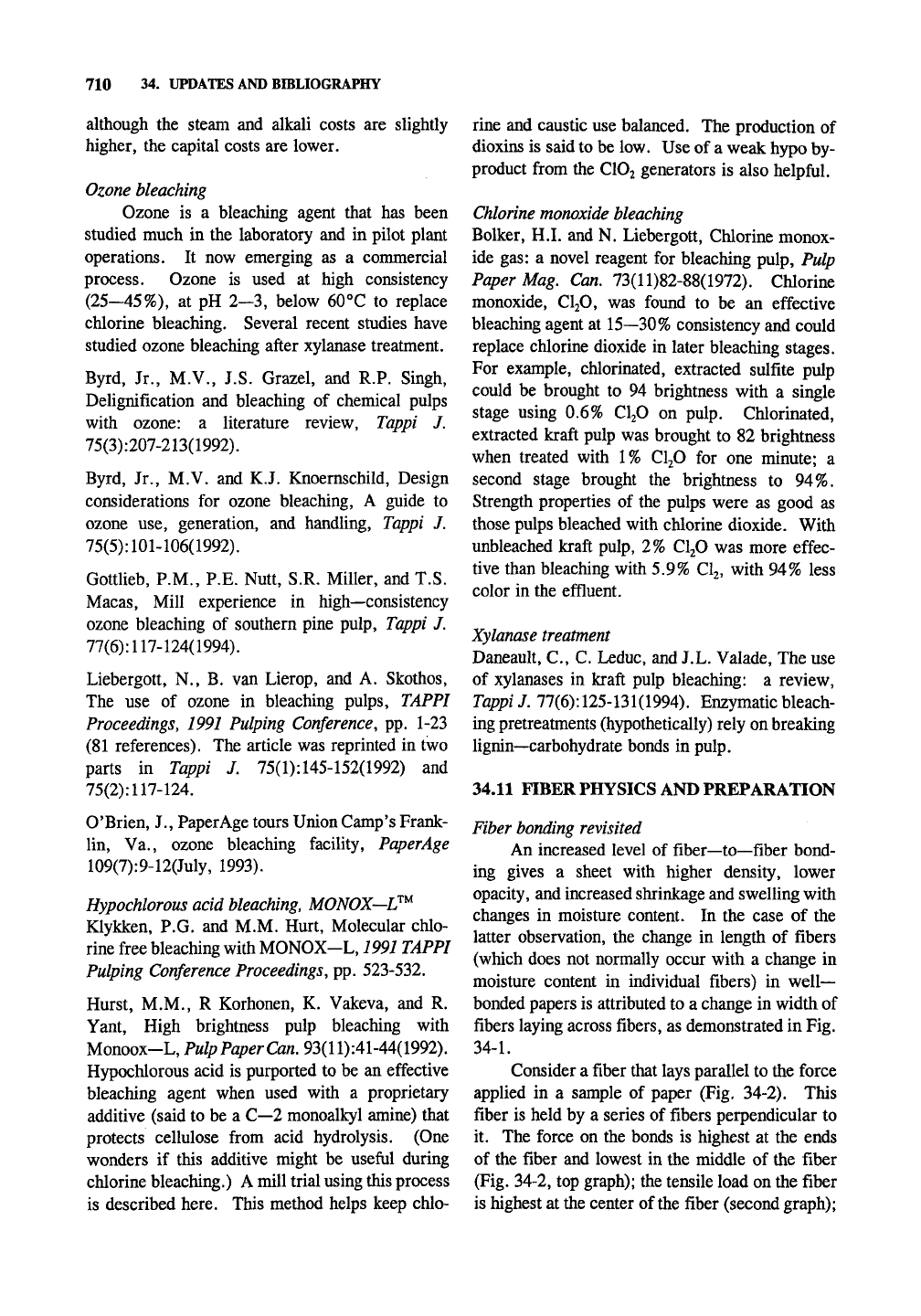
710 34. UPDATES AND BIBLIOGRAPHY
although the steam and alkali costs are slightly
higher, the capital costs are lower.
Ozone bleaching
Ozone is a bleaching agent that has been
studied much in the laboratory and in pilot plant
operations. It now emerging as a commercial
process. Ozone is used at high consistency
(25—45%),
at pH 2—3, below 60°C to replace
chlorine bleaching. Several recent studies have
studied ozone bleaching after xylanase treatment.
Byrd, Jr., M.V., J.S. Grazel, and R.P. Singh,
Delignification and bleaching of chemical pulps
with ozone: a literature review, Tappi J.
75(3):207-213(1992).
Byrd, Jr., M.V. and K.J. Knoernschild, Design
considerations for ozone bleaching, A guide to
ozone use, generation, and handling, Tappi J.
75(5):
101-106(1992).
Gottlieb, P.M., P.E. Nutt, S.R. Miller, and T.S.
Macas, Mill experience in high—consistency
ozone bleaching of southern pine pulp, Tappi J,
77(6):
117-124(1994).
Liebergott, N., B. van Lierop, and A. Skothos,
The use of ozone in bleaching pulps, TAPPI
Proceedings^ 1991 Pulping Conference, pp. 1-23
(81 references). The article was reprinted in two
parts in Tappi J.
75(1):
145-152(1992) and
75(2):
117-124.
O'Brien, J., PaperAge tours Union Camp's Frank-
lin, Va., ozone bleaching facility, PaperAge
109(7):9-12(July, 1993).
Hypochlorous acid
bleaching,
M0N0X—I7^
Klykken, P.O. and M.M. Hurt, Molecular chlo-
rine free bleaching with MONOX-L,
1991
TAPPI
Pulping Conference Proceedings, pp. 523-532.
Hurst, M.M., R Korhonen, K. Vakeva, and R.
Yant, High brightness pulp bleaching with
Monoox-L, PulpPaperCan, 93(11):41-44(1992).
Hypochlorous acid is purported to be an effective
bleaching agent when used with a proprietary
additive (said to be a C—-2 monoalkyl amine) that
protects cellulose from acid hydrolysis. (One
wonders if this additive might be useful during
chlorine bleaching.) A mill trial using this process
is described here. This method helps keep chlo-
rine and caustic use balanced. The production of
dioxins is said to be low. Use of a weak hypo by-
product from the CIO2 generators is also helpful.
Chlorine
monoxide bleaching
Bolker, H.I. and N. Liebergott, Chlorine monox-
ide gas: a novel reagent for bleaching pulp. Pulp
Paper Mag. Can, 73(11)82-88(1972). Chlorine
monoxide, CI2O, was found to be an effective
bleaching agent at 15—30% consistency and could
replace chlorine dioxide in later bleaching stages.
For example, chlorinated, extracted sulfite pulp
could be brought to 94 brightness with a single
stage using 0.6% CljO on pulp. Chlorinated,
extracted kraft pulp was brought to 82 brightness
when treated with 1% CljO for one minute; a
second stage brought the brightness to 94%.
Strength properties of the pulps were as good as
those pulps bleached with chlorine dioxide. With
unbleached kraft pulp, 2% CljO was more effec-
tive than bleaching with 5.9% CI2, with 94% less
color in the effluent.
Xylanase treatment
Daneault, C, C. Leduc, and J.L. Valade, The use
of xylanases in kraft pulp bleaching: a review,
Tappi
J. 77(6):125-131(1994). Enzymatic bleach-
ing pretreatments (hypothetically) rely on breaking
lignin—carbohydrate bonds in pulp.
34.11 FIBER PHYSICS AND PREPARATION
Fiber bonding revisited
An increased level of fiber—to—fiber bond-
ing gives a sheet with higher density, lower
opacity, and increased shrinkage and swelling with
changes in moisture content. In the case of the
latter observation, the change in length of fibers
(which does not normally occur with a change in
moisture content in individual fibers) in well-
bonded papers is attributed to a change in width of
fibers laying across fibers, as demonstrated in Fig.
34-1.
Consider a fiber that lays parallel to the force
applied in a sample of paper (Fig. 34-2). This
fiber is held by a series of fibers perpendicular to
it. The force on the bonds is highest at the ends
of the fiber and lowest in the middle of the fiber
(Fig. 34-2, top graph); the tensile load on the fiber
is highest at the center of
the
fiber (second graph);
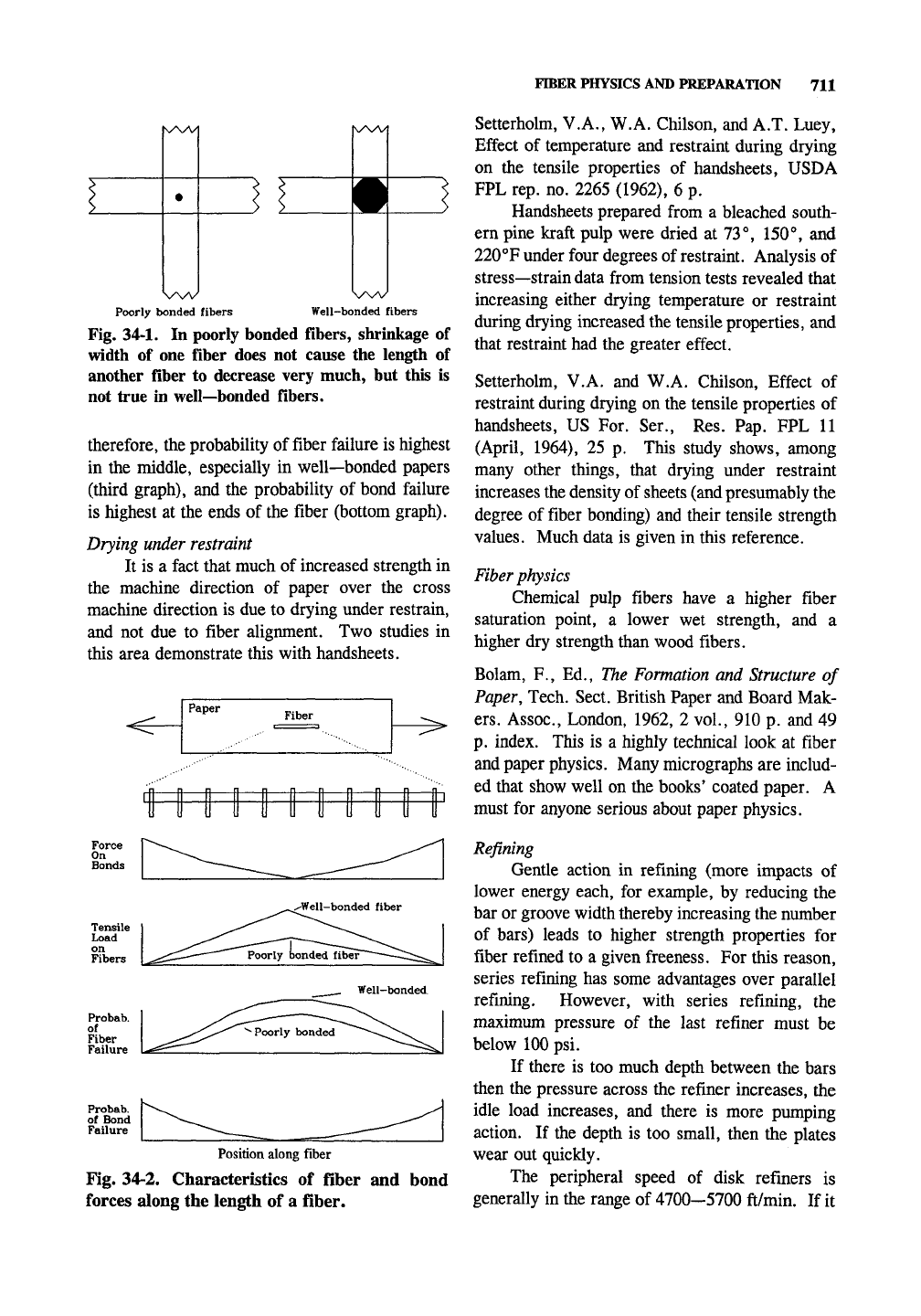
FffiER PHYSICS AND PREPARATION 711
Poorly bonded fibers Well-bonded fibers
Fig. 34-1. In poorly bonded fibers, shrinkage
of
width
of
one fiber does
not
cause
the
length
of
another fiber
to
decrease very much,
but
this
is
not true
in
well—bonded fibers.
therefore, the probability of fiber failure is highest
in the middle, especially
in
well—bonded papers
(third graph), and
the
probability
of
bond failure
is highest
at
the ends
of
the fiber (bottom graph).
Drying under restraint
It
is a
fact that much
of
increased strength in
the machine direction
of
paper over
the
cross
machine direction
is
due
to
drying under restrain,
and
not due to
fiber alignment.
Two
studies
in
this area demonstrate this with handsheets.
,^
^-^
Force
On
Bonds
Tensile
Load
on
Fibers
in
Paper
Fiber
^-^
.--^
fl 1
U
U
u u u u u u u u u
Poorly
.„^ell-bonded fiber
bonded fiber
-^
Well-bonded
Position along fiber
Fig. 34-2. Characteristics
of
fiber
and
bond
forces along the length
of a
fiber.
Setterholm, V.A., W.A. Chilson, and A.T. Luey,
Effect
of
temperature and restraint during drying
on
the
tensile properties
of
handsheets, USD A
FPL rep. no. 2265 (1962),
6 p.
Handsheets prepared from
a
bleached south-
ern pine kraft pulp were dried
at
73°, 150°,
and
220°F under four degrees of restraint. Analysis of
stress—strain data from tension tests revealed that
increasing either drying temperature
or
restraint
during drying increased the tensile properties, and
that restraint had the greater effect.
Setterholm,
V.A. and
W.A. Chilson, Effect
of
restraint during drying on the tensile properties
of
handsheets,
US For. Ser., Res. Pap. FPL 11
(April, 1964),
25 p.
This study shows, among
many other things, that drying under restraint
increases the density of sheets (and presumably the
degree
of
fiber bonding) and their tensile strength
values. Much data
is
given
in
this reference.
Fiber
physics
Chemical pulp fibers have
a
higher fiber
saturation point,
a
lower
wet
strength,
and a
higher dry strength than wood fibers.
Bolam,
F., Ed.,
The Formation and Structure
of
Paper, Tech. Sect. British Paper and Board Mak-
ers.
Assoc, London, 1962,
2
vol., 910
p.
and
49
p.
index. This
is a
highly technical look
at
fiber
and paper physics. Many micrographs are includ-
ed that show well on the books' coated paper.
A
must
for
anyone serious about paper physics.
Refining
Gentle action
in
refining (more impacts
of
lower energy each,
for
example,
by
reducing
the
bar or groove width thereby increasing the number
of bars) leads
to
higher strength properties
for
fiber refined to
a
given freeness. For this reason,
series refining has some advantages over parallel
refining. However, with series refining,
the
maximum pressure
of the
last refiner must
be
below 100 psi.
If there
is
too much depth between the bars
then the pressure across the refiner increases,
the
idle load increases,
and
there
is
more pumping
action.
If
the depth
is too
small, then
the
plates
wear out quickly.
The peripheral speed
of
disk refiners
is
generally in the range
of
4700—5700 ft/min.
If
it
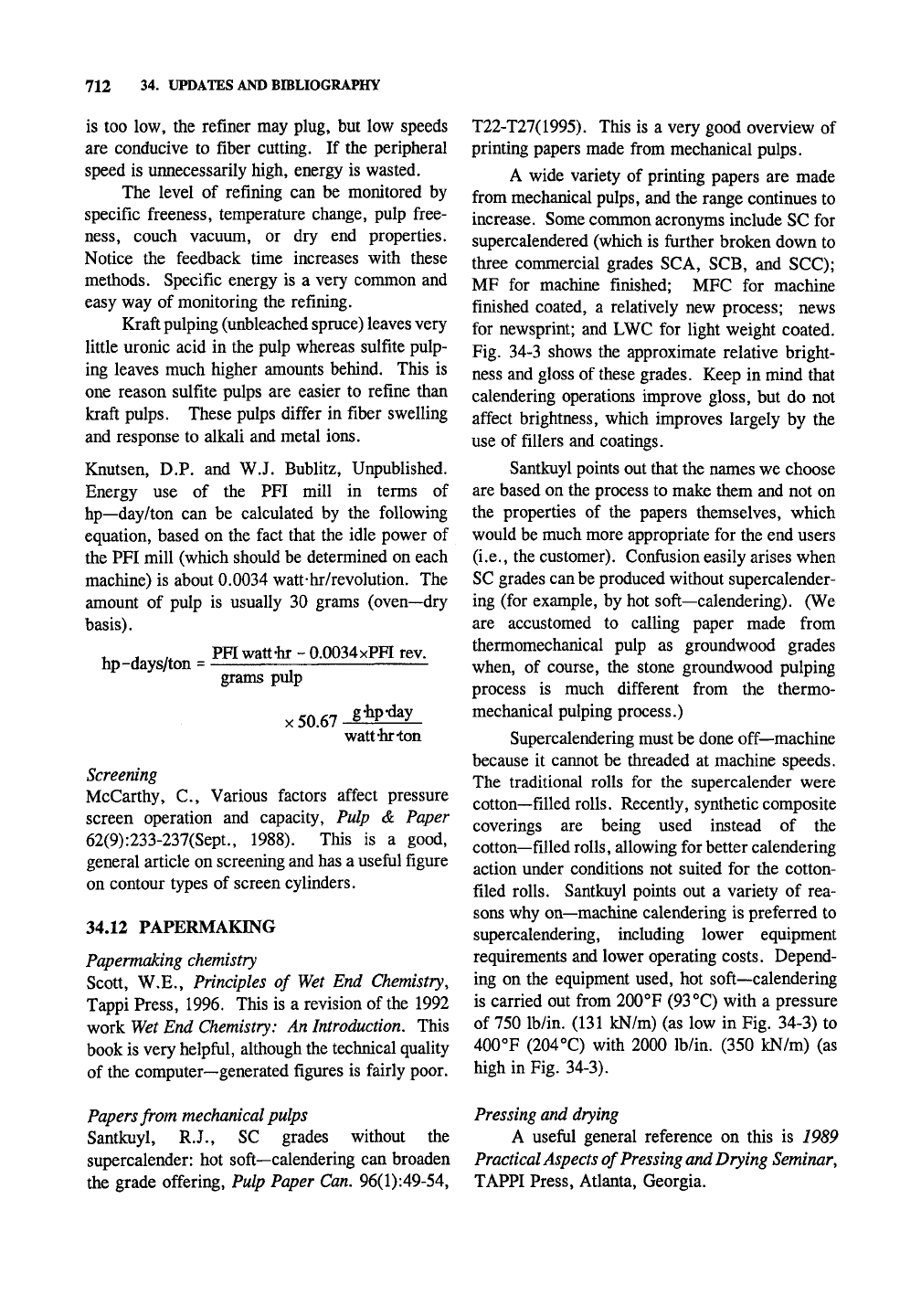
712 34. UPDATES
AND
BIBLIOGRAPHY
is too low, the refiner may plug, but low speeds
are conducive to fiber cutting. If the peripheral
speed is unnecessarily high, energy is wasted.
The level of refining can be monitored by
specific freeness, temperature change, pulp free-
ness,
couch vacuum, or dry end properties.
Notice the feedback time increases with these
methods. Specific energy is a very common and
easy way of monitoring the refining.
Kraft pulping (unbleached spruce) leaves very
little uronic acid in the pulp whereas sulfite pulp-
ing leaves much higher amounts behind. This is
one reason sulfite pulps are easier to refine than
kraft pulps. These pulps differ in fiber swelling
and response to alkali and metal ions.
Knutsen, D.P. and W.J. Bublitz, Unpublished.
Energy use of the PFI mill in terms of
hp—day/ton can be calculated by the following
equation, based on the fact that the idle power of
the PFI mill (which should be determined on each
machine) is about 0.0034 watt-hr/revolution. The
amount of pulp is usually 30 grams (oven—dry
basis).
PFI watt-hr - 0.0034xPFI rev.
hp-days/ton =
grams pulp
X
50.67
g'hp-day
watt-hr Ion
Screening
McCarthy, C, Various factors affect pressure
screen operation and capacity. Pulp & Paper
62(9):233-237(Sept., 1988). This is a good,
general article on screening and has a useful figure
on contour types of screen cylinders.
34.12 PAPERMAKENG
Papermaking chemistry
Scott, W.E., Principles of Wet End Chemistry,
Tappi Press, 1996. This is a revision of the 1992
work Wet End
Chemistry:
An Introduction. This
book is very helpful, although the technical quality
of the computer—generated figures is fairly poor.
Papers from
mechanical
pulps
Santkuyl, R.J., SC grades without the
supercalender: hot soft—calendering can broaden
the grade offering, Pulp Paper
Can.
96(l):49-54,
T22-T27(1995). This is a very good overview of
printing papers made from mechanical pulps.
A wide variety of printing papers are made
from mechanical pulps, and the range continues to
increase. Some common acronyms include SC for
supercalendered (which is further broken down to
three commercial grades SCA, SCB, and SCC);
MF for machine finished; MFC for machine
finished coated, a relatively new process; news
for newsprint; and LWC for light weight coated.
Fig. 34-3 shows the approximate relative bright-
ness and gloss of these grades. Keep in mind that
calendering operations improve gloss, but do not
affect brightness, which improves largely by the
use of fillers and coatings.
Santkuyl points out that the names we choose
are based on the process to make them and not on
the properties of the papers themselves, which
would be much more appropriate for the end users
(i.e.,
the customer). Confusion easily arises when
SC grades can
be
produced without supercalender-
ing (for example, by hot soft—calendering). (We
are accustomed to calling paper made from
thermomechanical pulp as groundwood grades
when, of course, the stone groundwood pulping
process is much different from the thermo-
mechanical pulping process.)
Supercalendering must be done off—machine
because it cannot be threaded at machine speeds.
The traditional rolls for the supercalender were
cotton—filled rolls. Recently, synthetic composite
coverings are being used instead of the
cotton—filled
rolls,
allowing for better calendering
action under conditions not suited for the cotton-
filed
rolls.
Santkuyl points out a variety of rea-
sons why on—machine calendering is preferred to
supercalendering, including lower equipment
requirements and lower operating costs. Depend-
ing on the equipment used, hot soft—calendering
is carried out from 200°F (93°C) with a pressure
of 750 lb/in. (131 kN/m) (as low in Fig. 34-3) to
400°F (204°C) with 2000 lb/in. (350 kN/m) (as
high in Fig. 34-3).
Pressing and drying
A useftil general reference on this is 1989
Practical Aspects of Pressing and Drying Seminar,
TAPPI Press, Atlanta, Georgia.
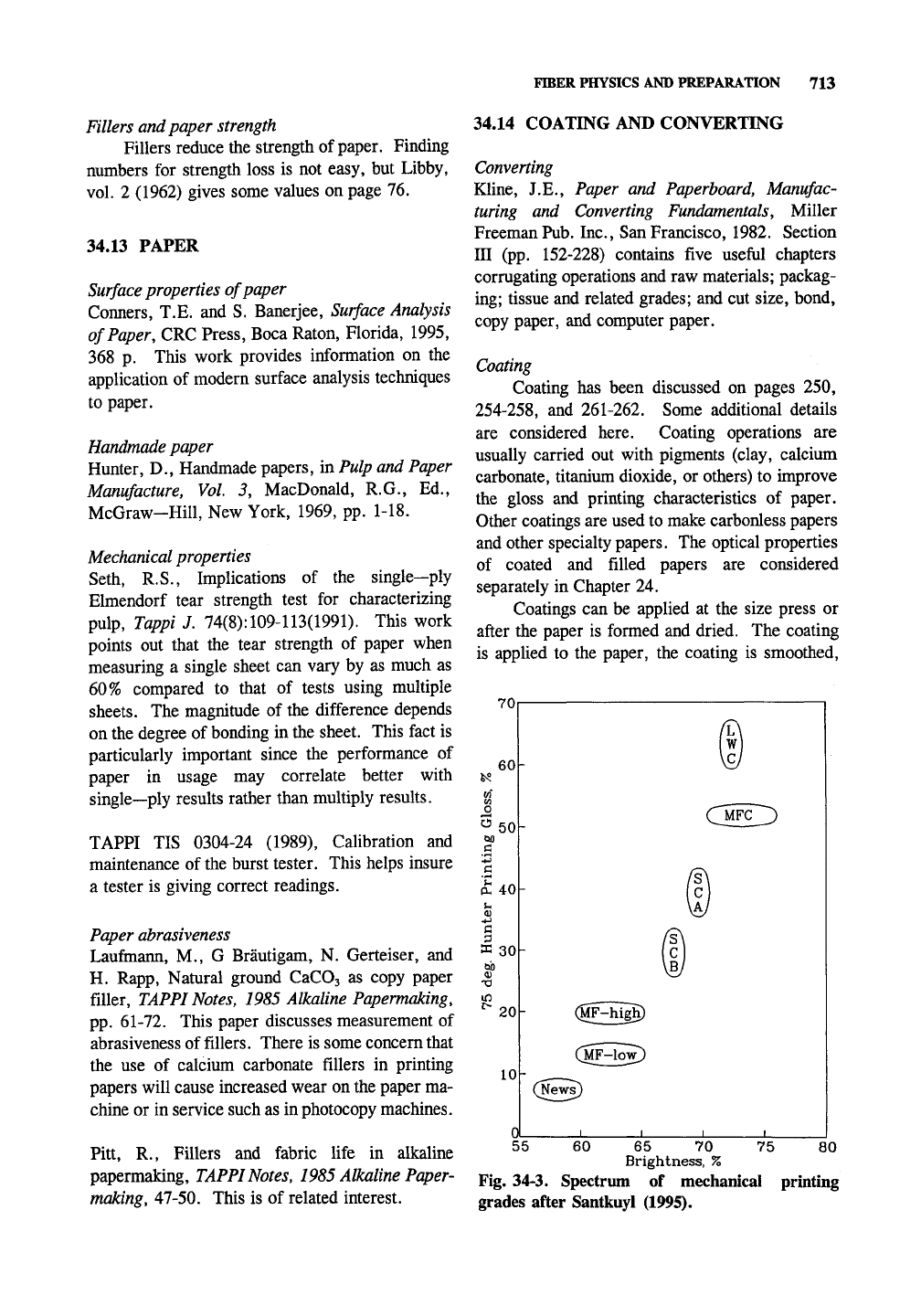
FIBER PHYSICS AND PREPARATION 713
Fillers and paper strength
Fillers reduce the strength of
paper.
Finding
numbers for strength loss is not easy, but Libby,
vol.
2 (1962) gives some values on page 76.
34.13 PAPER
Surface
properties of paper
Conners, T.E. and S. Banerjee, Surface Analysis
of Paper, CRC Press, Boca Raton, Florida, 1995,
368 p. This work provides information on the
application of modern surface analysis techniques
to paper.
Handmade
paper
Hunter, D., Handmade papers, in Pulp and Paper
Manufacture, Vol 5, MacDonald, R.G., Ed.,
McGraw-Hill, New York, 1969, pp. 1-18.
Mechanical
properties
Seth, R.S., Implications of the single—ply
Elmendorf tear strength test for characterizing
pulp,
Tappi J.
74(8):
109-113(1991).
This work
points out that the tear strength of paper when
measuring a single sheet can vary by as much as
60%
compared to that of tests using multiple
sheets. The magnitude of the difference depends
on the degree of bonding in the sheet. This fact is
particularly important since the performance of
paper in usage may correlate better with
single—ply results rather than multiply results.
TAPPI TIS 0304-24 (1989), Calibration and
maintenance of the burst tester. This helps insure
a tester is giving correct readings.
Paper
abrasiveness
Lauftnann, M., G Brautigam, N. Gerteiser, and
H. Rapp, Natural ground CaCOs as copy paper
filler,
TAPPI
Notes,
1985
Alkaline
Papermaking,
pp.
61-72. This paper discusses measurement of
abrasiveness of fillers. There is some concern that
the use of calcium carbonate fillers in printing
papers will cause increased wear on the paper ma-
chine or in service such as in photocopy machines.
Pitt, R., Fillers and fabric life in alkaline
papermaking, TAPPI Notes, 1985
Alkaline
Paper-
making, 47-50. This is of related interest.
34.14 COATING AND CONVERTING
Converting
Kline, I.E., Paper and Paperboard, Manufac-
turing and Converting Fundamentals, Miller
Freeman
Pub.
Inc., San Francisco, 1982. Section
III (pp. 152-228) contains five useful chapters
corrugating operations and raw materials; packag-
ing; tissue and related grades; and cut size, bond,
copy paper, and computer paper.
Coating
Coating has been discussed on pages 250,
254-258,
and 261-262. Some additional details
are considered here. Coating operations are
usually carried out with pigments (clay, calcium
carbonate, titanium dioxide, or others) to improve
the gloss and printing characteristics of paper.
Other coatings are used to make carbonless papers
and other specialty papers. The optical properties
of coated and filled papers are considered
separately in Chapter 24.
Coatings can be applied at the size press or
after the paper is formed and dried. The coating
is applied to the paper, the coating is smoothed,
70
60
o
3 50
g
(S
40
CI
ffi30
iO
20
10
55
60 75
80
65 70
Brightness,
%
Fig. 34-3. Spectrum of mechanical printing
grades after Santkuyl (1995).
